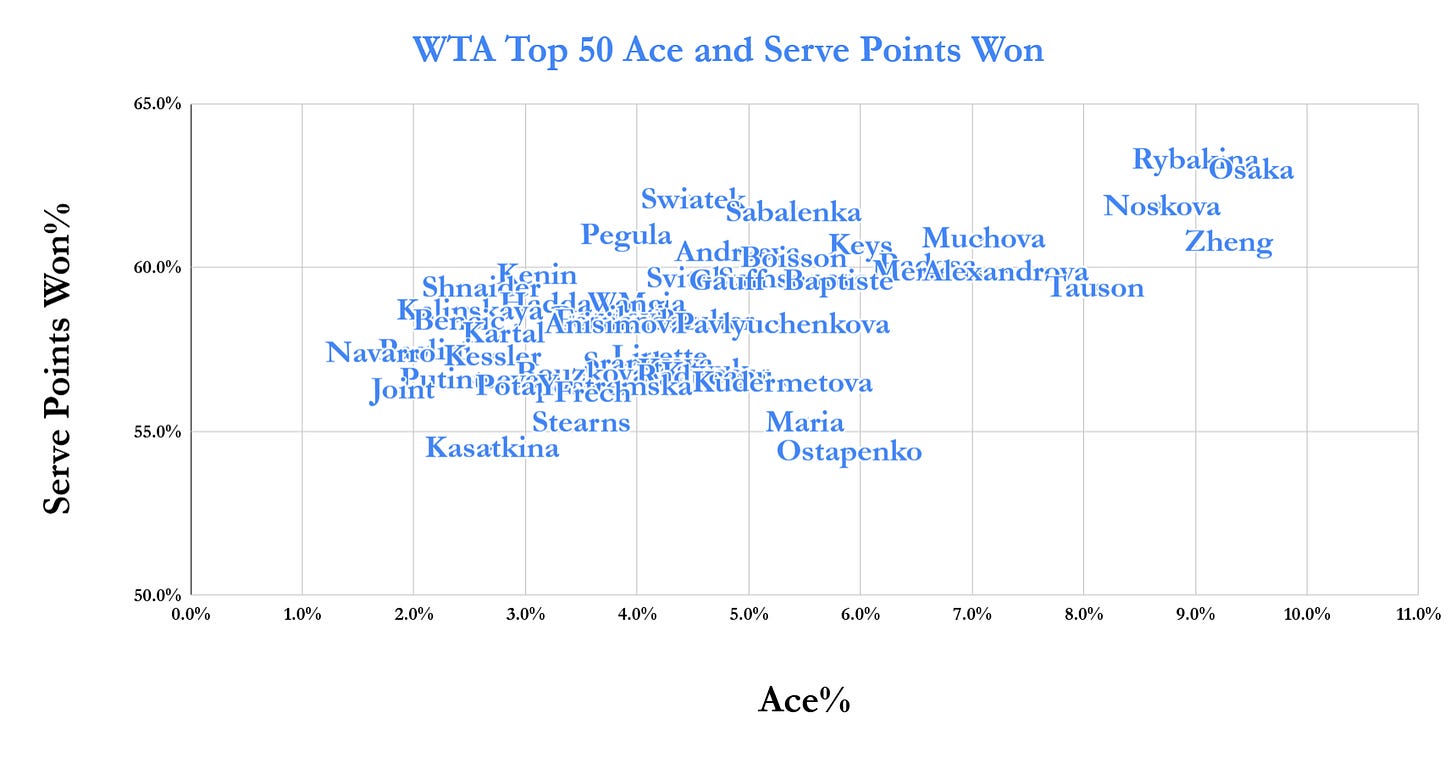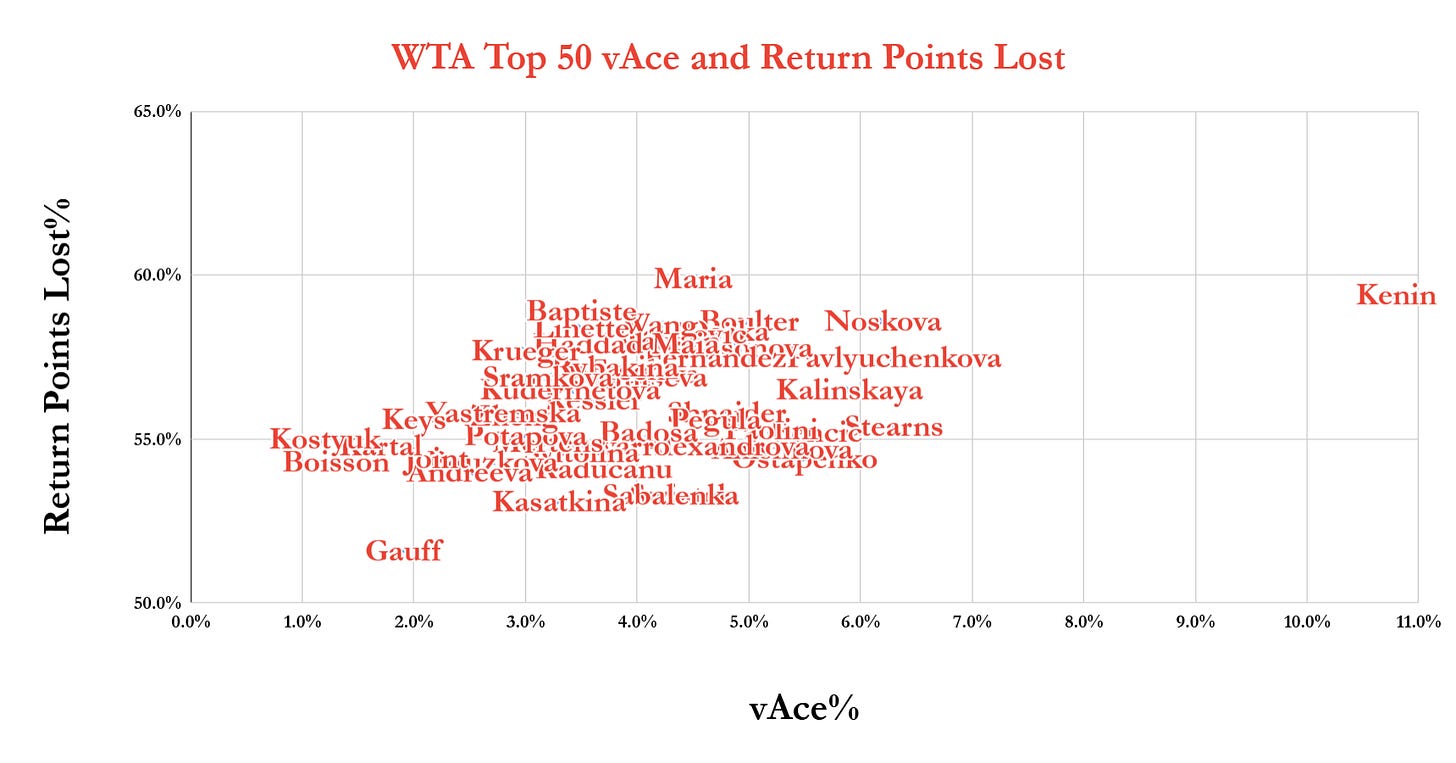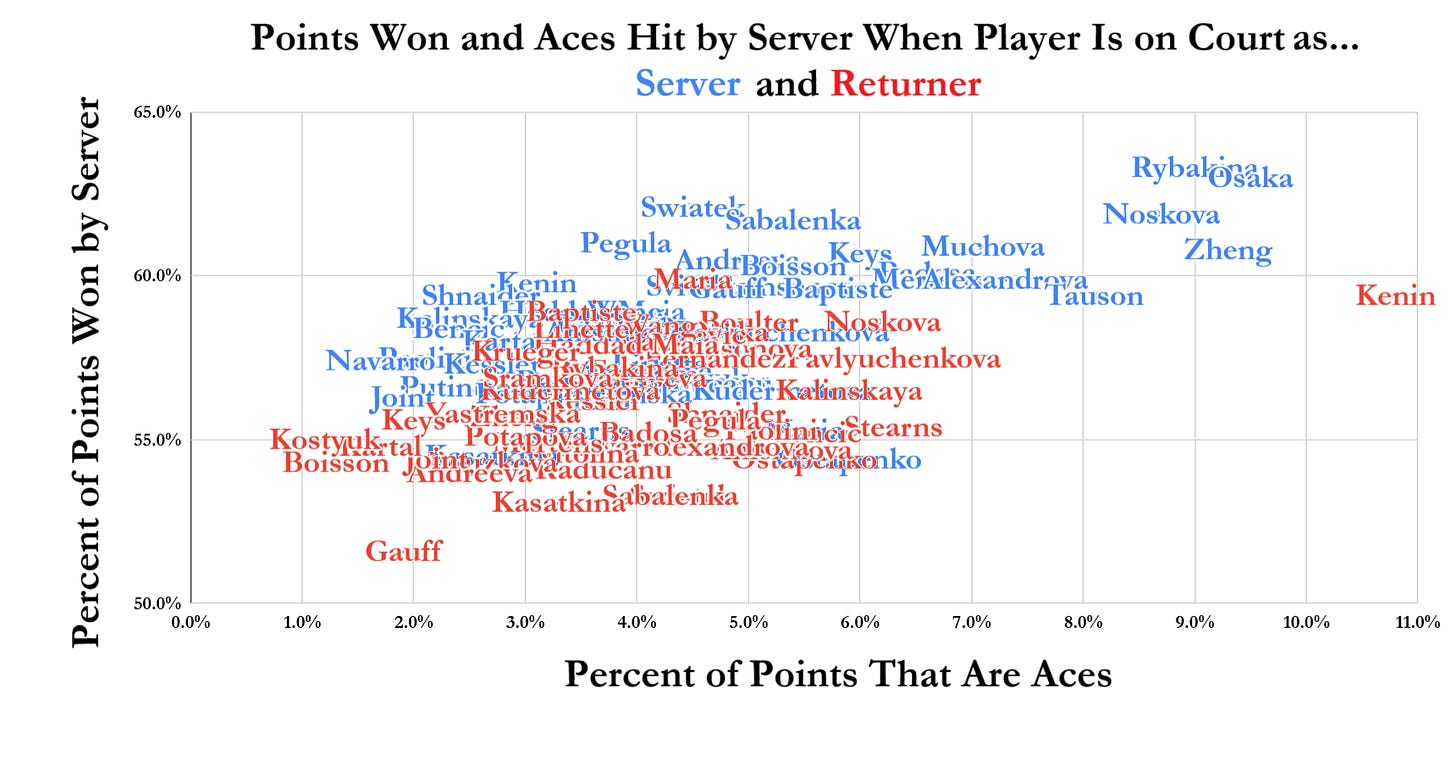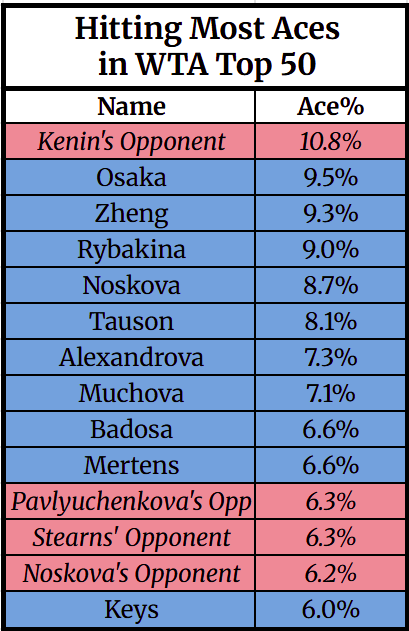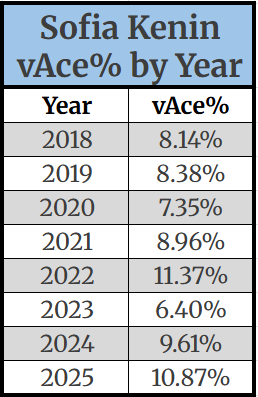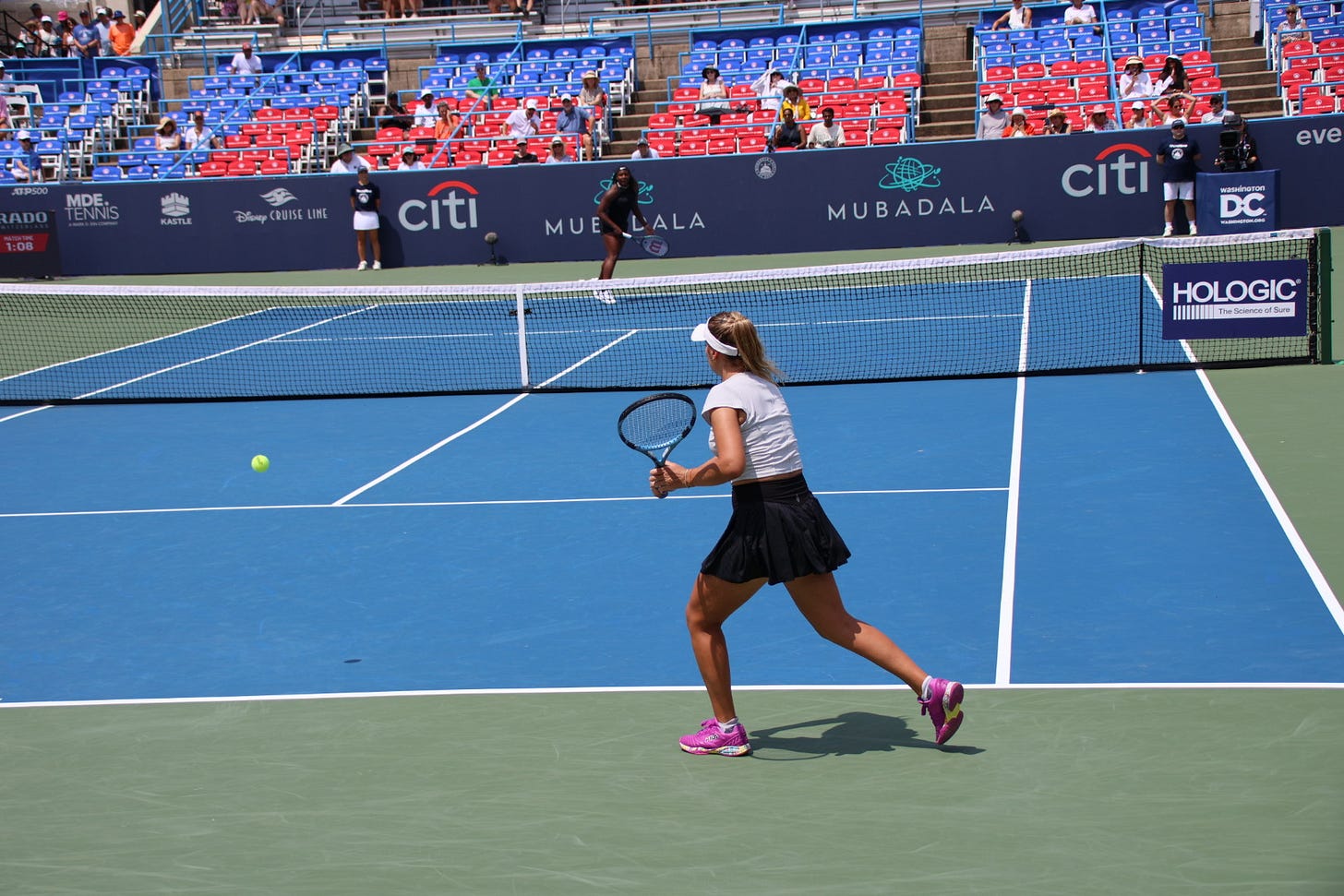She Can't Touch This
When it comes to aces, one player proves that it can be more about the returning than the serving.
One of the biggest challenges in telling the on-court stories of tennis is the lack of robust, reliable, uniform and openly accessible analytics.
Compared to sports like Major League Baseball, which has more than a century of high-quality numbers to mine for insights that have shaped the way both the sport’s past and present are discussed, tennis often struggles to have amply available facts and figures to even discuss the current season.
Statistical categories like winners and unforced errors are often used to tell the story of who won and lost a given match, but those metrics aren’t stored anywhere with enough regularity to paint a complete picture that shows a frame beyond one match or one tournament; it’s also not consistent which matches across the tour will even have those stats recorded.
The most complete skeleton of data we do have is the most barebones stuff, generated by what the chair umpires input into their score tablet after each point.
This is very limited stuff, but it’s dependable, objective, consistent and copious:
Who won the point?
Was it a first or second serve?
Was it an ace?
Was it a double fault?
This tennis season, I’ve been fascinated by a new way of looking at this limited information, as created by the treasure trove of Tennis Abstract. Instead of just tallying up who is hitting the aces, Tennis Abstract also tallies up who is getting aced most often.
Serving, and acing, is often considered the ultimate solo pursuit in tennis. After all, only one player touches the ball during an ace.
But this stat, called vAce% on Tennis Abstract, should change how we think about how aces happen. Because especially as it determines where the most aces are happening in women’s tennis right now, one specific returner plays an even bigger role than any server.
How to Talk About vAce% (Or, A Brief Word From Our Imaginary Sponsor)
I haven’t had any advertisers at Bounces, but if I did, this article about vAce% would surely be sponsored by Vace, a delicious Italian delicatessen in DC’s Cleveland Park neighborhood—which, fun fact, actually did sponsor my first Little League baseball team decades ago.


So, NB: if you’re talking about it around Bounces water coolers, “vAce%” is pronounced as it would be in Italian: VAH-chey. Only the likes of Nomi Malone would say it as one syllable.
How Aces Happen in Women’s Tennis
Who Is Hitting Aces
Now that we know the lingo, let’s look at the numbers for the last 52 weeks of the WTA Top 50, up to date as of August 5th on Tennis Abstract, which will build to our big revelation for this story.
Let’s start on the serving side. The average WTA Top 50 player wins 58.7 percent of points on serve. Tops are Elena Rybakina (63.3%), Naomi Osaka (63.0%), Iga Swiatek (62.1%), Linda Noskova (61.9%), and Aryna Sabalenka (61.7%). The lowest percentage of serve points won is by Jelena Ostapenko (54.4%).
The average WTA Top 50 player hits aces on 4.7% of points. The highest percentage of aces per point were being hit by Osaka (9.5%), Zheng Qinwen (9.3%), Rybakina (9.0%), Noskova (8.7%), and Clara Tauson (8.1%). The lowest percentage of aces was by Emma Navarro (1.7%).
Here’s how these two related factors look in a scatterplot. For the most part, the 50 players are reasonably clustered together, and points won on serve and aces are well correlated.
Who Is Getting Aced
But once we look at returning and getting aced stats among the WTA Top 50, one fascinating outlier is revealed.
The average WTA Top 50 player wins 44.0 percent of points on return. The most return points are won by Coco Gauff (48.4%), followed by Daria Kasatkina (46.9%), Sabalenka (46.7%), Swiatek (46.7%), and Mirra Andreeva (46.0%). The fewest return points won is by Tatjana Maria (40.1%).
Now for the vAce%: the average WTA Top 50 player gets aced on 4.1 percent of return points. The fewest aces are hit against Marta Kostyuk (1.2%), Lois Boisson (1.3%), Sonay Kartal (1.7%), Gauff (1.9%), and Madison Keys (2.0%).
The most aces, in a wild, wild outlier, are hit against Sofia Kenin, who gets aced on 10.8 percent of return points. As you can see on the below graph, Kenin is completely an island of her own away from the rest of the tightly-packed continent of players in this category.
Note that for this graph I flipped the Y-Axis to measure Return Points Lost so it would align better with the previous one.
Let’s combine those two graphs together to see how they overlap. It’s messy reading these 100 names overlapping, but 27th-ranked Kenin still stands wildly apart and makes for a remarkable revelation: more than any individual server, the player most likely to hit an ace right now in women’s tennis is whoever is playing against Sofia Kenin.
To display this differently, here’s what the combined metrics look like as a table, showing the top 15 most aceful scenarios on court right now among the WTA Top 50:
Sofia Kenin’s Wild Ride, at a Glimpse
Before we dive into the “why” of Sofia Kenin as the face of vAce%, it’s probably worth a bit of a refresher on her roller coaster journey as a world-class player, which has been a wild ride even when just focusing on the on-court elements.
Kenin was put into high-level tennis as a child and quickly gained notice as one of the most talented tots in the hotbed of Florida. When she was 6, she memorably shadowed Kim Clijsters around the Miami Open.
After reaching No. 2 in the junior rankings, Kenin steadily climbed up the WTA rankings without much fanfare, overshadowed by buzzier players in American tennis (particularly Coco Gauff). After runs to the semifinals of Toronto and Cincinnati in 2019, Kenin broke into the Top 20; a few months later she stunned presumptive champion No. 1 Ash Barty in the 2020 Australian Open semifinals. In the final against Garbiñe Muguruza, she summoned one of the most clutch moments in 21st Century tennis, digging back from a 0-40 hole in the final set by hitting five consecutive winners (the below video is cued up to that moment) to turn the match firmly in her favor and secure a Grand Slam title.
Kenin followed up her win in Melbourne by winning a small WTA tournament in Lyon. But right when she might’ve been ready for her star to shine brightest, playing in front of American fans in Indian Wells and Miami as the newest major champion, the pandemic hit and shut down the tour.
Kenin’s moment in the sun[shine double] didn’t come, but her results stayed strong in 2020, most notably by reaching the final of the autumnal 2020 French Open, where she earned the distinction of becoming the first player to lose to Iga Swiatek in a major final. Despite only being ranked No. 4, Kenin was voted the WTA’s Player of the Year for 2020; it was hard to imagine any one else deserving the award.
It’s worth noting, also, that something else happened to Kenin on court during that remarkable 2020 season: right before her run to the French Open final, Kenin got double bageled by Victoria Azarenka in her first match in Rome. Even at her peak, Kenin’s highs were high and the lows were extremely low.
Kenin talked openly about feeling overwhelmed by pressure to repeat her results when the 2021 season began, and she struggled throughout the season. The low point came in a 6-4, 6-2 loss to Madison Brengle in the second round of Wimbledon; the scoreline of the loss didn’t look horrendous, but the performance was shocking who anyone who watched it: Kenin was on wild tilt throughout the match, racing to lose points as fast as possible against 82nd-ranked Brengle, one of the least powerful players on tour (who hit zero aces in the match).
Sensing something historically bad had transpired, I checked with IBM after the match, and they confirmed that 41 unforced errors Kenin hit in the 45-minute loss set a Wimbledon record for most unforced errors per minute at 0.91 per minute; the previous record was 0.69; the women’s singles average was 0.21 per minute.
Kenin didn’t play another match that season; she cited Covid as her reason from withdrawing from the U.S. Open. Because of pandemic-related rankings freezes, Kenin’s ranking didn’t implode until early 2022, when she lost in the first round to Madison Keys and her 2,000 points from 2020 expired.
She missed a few months with a foot injury in mid-2022 and fell out of the rankings entirely. She came back in Washington but finished the year outside the top 200.
In 2023, she pulled off a couple big wins, beating Aryna Sabalenka in Rome and Coco Gauff at Wimbledon. After more than 18 months outside the Top 100, Kenin broke back into the Top 50 by the end of the season.
A year later Kenin had again plunged back outside the Top 150, but made the final of WTA 500 Tokyo in late 2024 to put herself back in the Top 100, continuing her seesaw journey.
Kenin’s vAce% has also fluctuated along with her fortunes, but it’s remained high throughout. Even the best season she’s had on tour for vAce%—6.4 percent in 2023—is higher than any other player’s vAce% in the current WTA Top 50.
Keeping Up With Kenin This Year
My fascination with vAce% started at the beginning of this year, so I have been tracking Kenin’s results through this lens all season. I’ve also asked several of Kenin’s opponents and a few coaches on tour if they were aware of her unusual vAce% stat; none have said they were.
In the first match of Kenin’s I watched this year—a tough first round draw against in-form third-ranked Coco Gauff at the Australian Open—Gauff hit 12 aces—equating to aces on 16.2 percent of serves, which still stands as her second-highest percentage in the 44 matches she’s played so far this year.1
I was curious how aware opponents might be about Kenin’s aceability, so after that win in Melbourne, I asked Gauff if she knew going into the match that Kenin was likely going to be easier to ace than other opponents; she said she didn’t, but that she saw Kenin struggling as the match progressed.
“They didn't prep me on that, saying she's easier to get aced,” Gauff said. “Yeah, going into the match, I didn't really know that, I guess.
“But I mean, it makes sense. I did notice that she was guessing a lot on my serve, so I think obviously when a person starts guessing, it's kind of like you feel good because it's kind of like they don't know where you’re serving.
“So, yeah, I mean, I've always known her to be a good returner, so I never knew that there was that stat against her. Yeah, I think today, I don't know, I just felt like she was guessing, and I did a good job of mixing my serve up. Especially on the deuce side, I don't think she knew—and sometimes I barely knew where I was serving.”
On their second meeting this year in Miami, Gauff only hit aces on 2.9 percent of serves…but won 6-0, 6-0.
I was first able to talk to Kenin herself about this topic in April in Charleston, after her first round win over Bernarda Pera. When I broached the topic of getting aced, Kenin readily told me she was aware it was an issue for her, something she could see just by looking at the basic stats after each match.
“Sometimes I get aced 10, 12 times,” Kenin said. “I obviously look at the stats, so I'm like, ‘Damn it, not something I like to see!’ But I'm hoping to win the match. If I win the match, then that's fine if they're acing me. But usually I don't win, so I try to be more aggressive on return now.”
I mentioned to Kenin one player on the opposite end of the vAce% spectrum: Madison Keys, who then had the second-lowest vAce%, and is still in the bottom five at 2.0 percent.
“I can’t imagine her getting aced,” Kenin said of Keys.
I had spoken to Keys about it a day earlier; she said she hadn’t been aware of her own strength in this category.
“I would honestly say it's probably because I have long arms? I think that probably helps me,” Keys said. “I wish I had a better answer for you, but I didn’t even know I was at the top of that.”
Wingspan could certainly would play a role, but height doesn’t always correlate fully onto the vAce% rankings; 5-foot-4 Sonay Kartal barely gets aced, while 5-foot-11 Naomi Osaka gets aced a good amount.
Kenin said she was “not sure” how much she could improve her numbers on getting aced through practice, but said she was working on split-stepping and reacting during her fitness work. But she added that “we’re addressing it definitely, especially this year.”
Kenin works with a hitting partner, and said she works on the issue by trying to return his fastest serves.
“We just tell him to like bomb serves—like, literally bomb them,” she said. “And I still keep getting aced. But the less the better? I don't know.”
Kenin’s coach, her father Alex Kenin, didn’t want to do any interviews, but told me when we spoke briefly in Charleston that he was aware it was an issue: “One thing I will say is: she’s standing too far back,” he said.
When I asked his daughter what she thought was causing this issue for her, I was interested to hear her admit that there was a large mental component to it.
“Getting aced by big servers like Coco and Rybakina, that's understandable,” she said. “And sometimes when I get aced against players which are not the biggest servers, my head's not entirely there. I'm not really as focused. So today [in Charleston R1 vs Bernarda Pera, aced 10.1 percent] I did not get aced that much. So we're good, we're making baby steps. And this year overall in terms of aces has been way more mild than previous years.”
When she’s getting aced the most, “I'm kind of not like in the zone,” Kenin said. “But when I'm in the zone, I'm in the zone. It's tough to beat me.”
Kenin proved to be tough to beat throughout that week in Charleston, reaching the final of the WTA 500 event to put herself close to a return to the Top 30. Remarkably for Kenin, who is both erratic and resilient, it was the second time in her career that she made a tournament final a week after getting double bageled.
When I next spoke with Kenin a few months later, those fluctuations were clear to see even within one week, ending with what became the worst returning match of her career.
Wherever her “zone” was, she left Washington nowhere near it.
Kenin’s Summer vAce-ation
Baptiste Baptism
Kenin’s first match of the North American hardcourt summer came in Washington against local favorite Hailey Baptiste. Kenin gave up nine aces—a vAce% of 11.7 percent—but was happy with how she fared in a first round victory.
“I mean, I feel like today Hailey has a big serve so I expected to get aced, but I wasn't aced as much as I thought I would [be],” Kenin said after that 6-3, 7-6(3) win.
Following up from our Charleston chat, I asked if she was still working on not getting aced, and she mentioned the same method.
“Just having my hitter just literally bomb serves,” she said.
Kenin wasn’t getting aced on big points, including late in the second set when she broke Baptiste to stay in the second set and then won it in a tiebreak. Here’s what those nine aces looked like in a supercut:
But in the second round in Washington, there would be an explosion of aces like even Kenin had never experienced before.
Way Down Against Townsend
Kenin’s second round opponent was qualifier Taylor Townsend, whom Kenin had recently beat in straight sets in the first round of Wimbledon.
This time, the result was dramatically reversed: Townsend won 6-3, 6-0.
But fitting what I had been tracking, the story of the match was Kenin getting aced, early, easily, and often.
According to the Tennis Channel broadcast, the 12 aces Townsend hit in the first set against Kenin were an all-time one-set record in WTA history. That’s remarkable under any circumstances, but especially because it wasn’t even an especially long set. Adding to the staggering nature of the haul, two of the aces were on second serves.
Townsend hit five more aces in the quick second set to finish with a total of 17. The resultant 39.5 percent ace percentage was by far the highest of Townsend’s career in a completed match, beating a 2024 win in Charleston where she hit aces on 21.7 percent of points in a win against…Sofia Kenin.
But even for Kenin, this was bad. The 39.5 percent vAce% was the highest of Kenin’s career, surpassing her previous record of 35.4 percent against Ash Barty in Adelaide in 2022 (the highest ace rate of Barty’s illustrious career).
But more than the sheer number, what was most striking was watching Kenin out there. Many of the serves looked reachable, but Kenin made little effort to move for them. This supercut of the 17 aces shows a mix of some good serves and some serves that Kenin absolutely could’ve reached with readiness and reactivity, rather than playing at a casual walking pace.
WTA world feed commentator Pete Odgers began commenting on Kenin’s lackluster return effort as the second set wore on.
“Just a little unusual,” Odgers said after one ace. “I mean that was a very good serve, but you just got to wonder with Kenin…just been a little slow off the mark off the return—wonder whether she's feeling 100 percent? But another ball goes whizzing past her, and another ace is added to the tally for Townsend.”
After the 14th ace, Odgers began offering theories. “Almost seems like a bit of dizziness from Kenin?” Odgers wondered. “Just not picking up the serves. I mean, it's a decent serve, that, but it's not like it's fired down 120 miles per hour.”
After the 17th and ultimately final ace from Townsend, Odgers was at a loss. “Again, no attempt to go for the ball from Kenin,” he said. “It's been a strange performance from the sixth seed, there's no doubt about that.”
“A little baffling with regards to the performance from Kenin,” Odgers said as Kenin walked off the court in defeat. “Especially off the return, was just not reading the ball.”
In her post-match press conference, Townsend said she hadn’t noticed anything unusual from Kenin or reading openings in her game.
“When we played in Wimbledon, she had changed her return positioning to take away my favorite serves, and she was in the same spots again today,” Townsend said. “…So, I mean, no, it wasn't anything that I was reading. I saw where she was standing, but it was more so I was just focused on where I wanted to hit the ball.”
Townsend had also praised Kenin’s returning abilities.
“Sonia's a really great returner,” Townsend said of Kenin. “She takes the ball really early and is able to create angles off of angles, so I knew that I had to be really intentional with my spots. So for me to be able to serve that way against her, like, it gives me a lot of confidence going into my next match.”
Townsend would only hit aces about an eighth as much in that next round, with a 5 percent ace rate in a quarterfinal loss to eventual champion Leylah Fernandez.
Mboko in Montreal
The third match Kenin has played this summer was a loss to surging Victoria Mboko in Montreal. Mboko, who has made a Cinderella run to the semifinals of her home tournament, hit 12 aces against Kenin in a 6-2, 6-3 win, good for 19.7 percent.
Mboko, who would go on to knock out top-seeded Coco Gauff soon after, hit a bunch of good serves, and Kenin wasn’t anywhere near as listless as the Townsend match. But as you can see in this supercut, Kenin probably could’ve made more of an effort on several of the returns.
Kenin’s Opposite Numbers
This post ultimately is more about presenting evidence than a decisive theory of the case, so I would be curious for more coaches, players, and analysts—of the professional and amateur variety—to chime in in the comments below about what they’re seeing.
I think my main take is the opposite of Kenin’s father: Kenin should be standing further back, not closer, to give herself more time to react to these serves. And even if she’s not successfully reaching all the serves coming at her, a commitment to at least reaching for and swinging at every serve might be a positive start, rather than getting on spirals of resignation.
I decided to make this opus of a Bounces post free for all to read in hopes of encouraging curiosity, answers and explanations on this topic, but if you enjoyed it I do hope you can subscribe to Bounces to support the work I’m doing and keep more stories coming!
Want even more on vAce%? Curious about how the ATP side compares?
Beyond the paywall below as a bonus for paid Bounces readers, a look at the American star who gets aced more than any other player in the ATP Top 50 and how he feels about it...and how he manages to make up for it.




